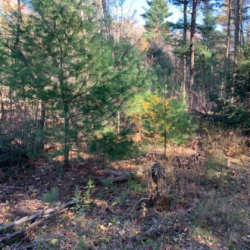 Finding friendship and sense of community while digging in the dirt doesn’t seem like a logical fit, but for the Buckthorn Bandits, it’s a way to connect deeper to the mission of Asbury Woods.
Finding friendship and sense of community while digging in the dirt doesn’t seem like a logical fit, but for the Buckthorn Bandits, it’s a way to connect deeper to the mission of Asbury Woods.
At Asbury Woods, volunteers like the self-named Buckthorn Bandits help us manage 205 acres of woods, wetlands, and meadows. One aspect of land management is monitoring for and removing invasive species, such as Buckthorn.
Buckthorn is native to Europe and Asia. The shrub was introduced as a decorative and space-filling shrub for residential landscaping. Buckthorn is problematic because it forms dense, unpassable thickets that crowd out native plants and prevent them from thriving. They grow like a tree/bush hybrid and can spread outward easily. It bears fruits with small berries which birds eat and then spread throughout the nearby areas. North America grosbeaks, starlings, robins, and waxwings, among other birds eat buckthorn. The laxative properties of the seed help to spread the invasive species.
Buckthorn is allopathic, which means that it produces a chemical in its roots that inhibits the growth of other plants around it. It can quickly become a monoculture, taking over the understory of the forest. This harms the ecosystem by decreasing the diversity of plants in the area which then diminishes the diversity of the wildlife in the area. Studies have shown that this chemical can also have a detrimental effect on the reproduction of salamanders.

Our persistent team of volunteers who are helping us to tackle this invasive species named themselves The Buckthorn Bandits. The Bandits include Bill Smith, Joe Sangemino, Russ Smith and Dave Fresch. Bill Smith has been an Asbury Woods volunteer for five years and in consultation with Mike Grandinetti, Facility and Grounds Manger, formulated a plan to make steady progress to remove buckthorn from areas adjacent to the boardwalk. Joe, Russ and Dave readily agreed to lend their time for this project and the group has been working Saturday mornings for several weeks. So far they have removed 3,000 pounds of this invasive plant from the Asbury Woods property.
“Committed volunteers are absolutely critical to our ability to undertake a project like this. The time, manpower and dedication they bring make it possible for us to see progress. It’s very important to manage invasive species because they steal resources from the native species,” said Michael Grandinetti, Facilities and Grounds Manager.
Bill Smith reflected on his experience, “I’ve been a volunteer of many organizations in Erie, including MYAA baseball, McDowell Band, the Boy and Girl Scouts of America, the Brig Niagara, and Asbury Woods. Volunteering is a win, win, win proposition for me. It benefits the organization and the community. We’re all working together and have a sense of belonging and contributing to Asbury Woods by removing this invasive species.”
If you are interested in volunteering for either ongoing projects or occasional needs, please contact Shelia Walmer at 814-835-5356 or swalmer@asburywoods.org or visit the Get Involved section of our website at www.asburywoods.org.
To learn more about buckthorn, please visit: https://extension.psu.edu/buckthorn
